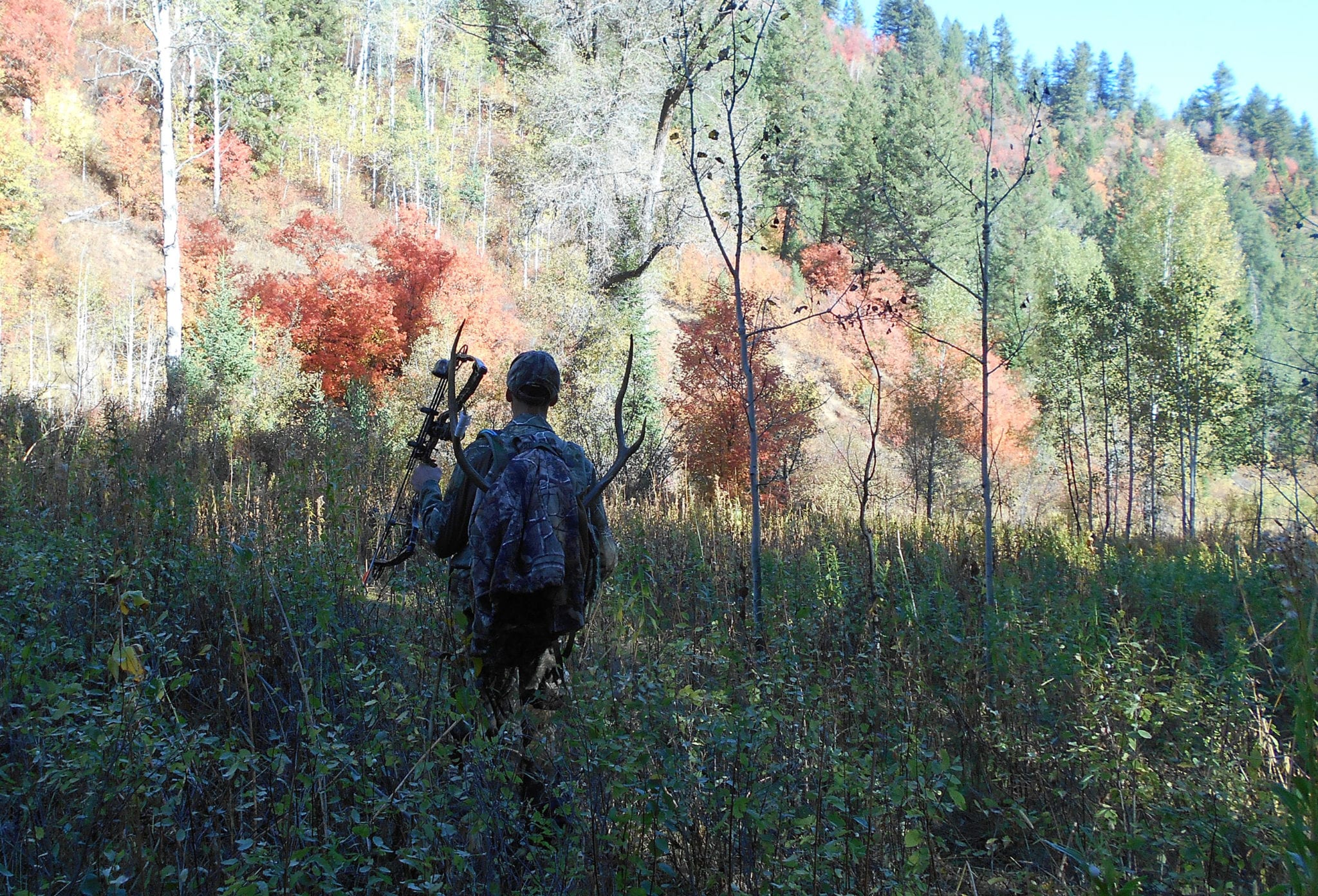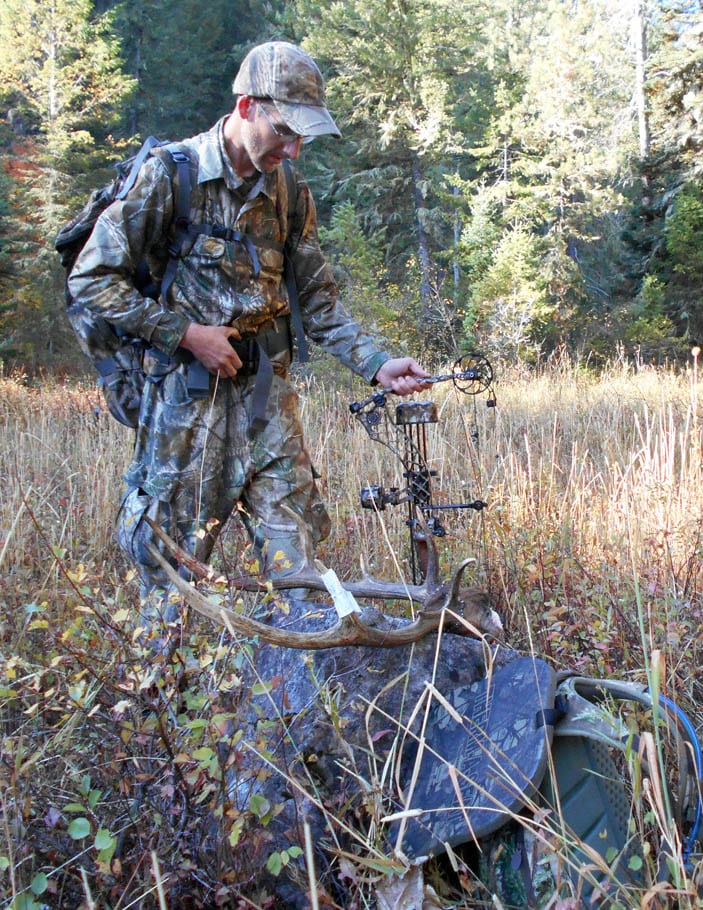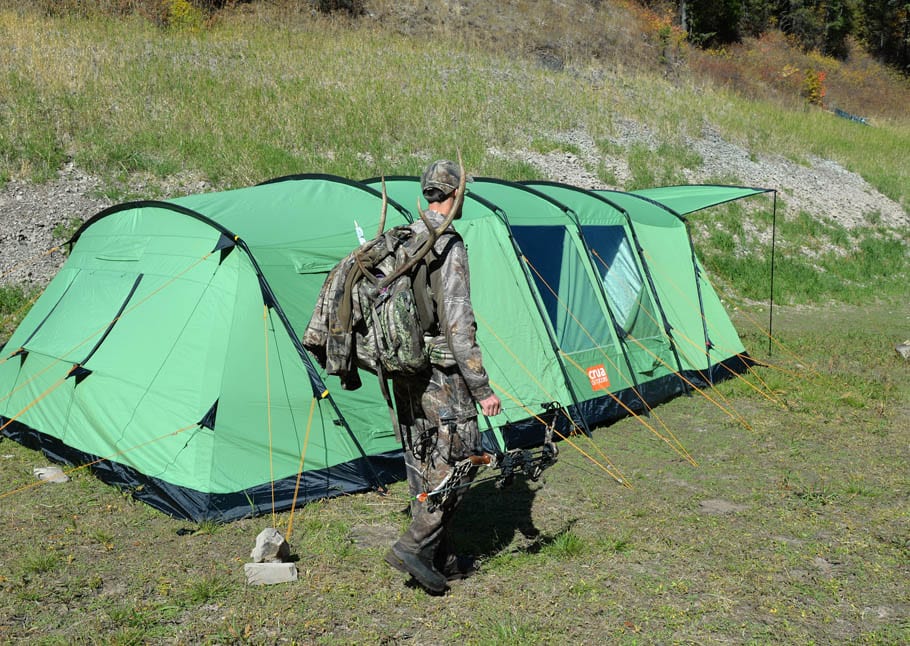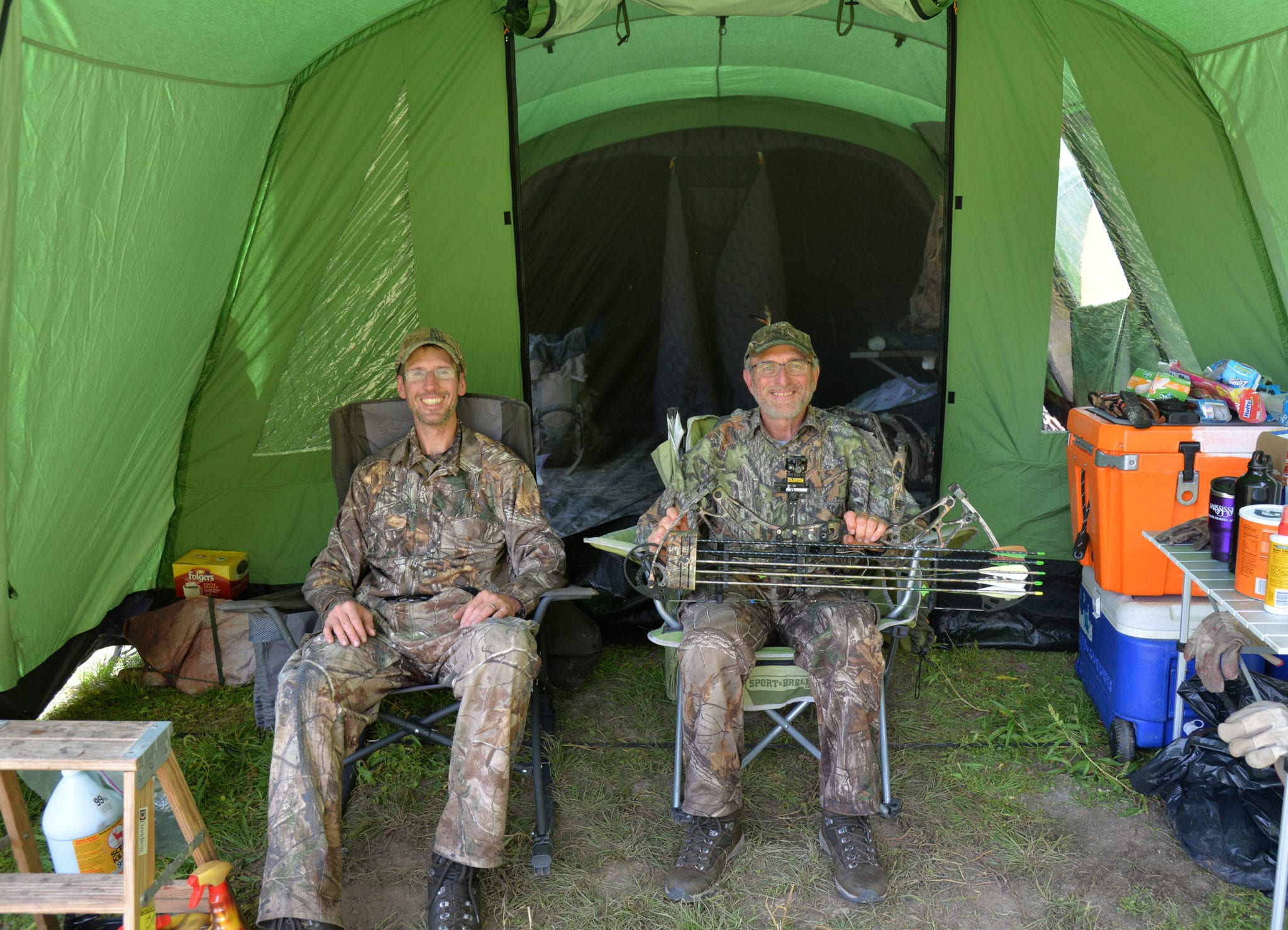Frogs chirped loudly in the darkness up the draw behind me as I strained beneath a backpack carrying about 75 pounds of elk meat.
What the heck? This draw in the Targhee-Caribou National Forest only carries water during spring runoffs as the mountains’ snow melts away. How could frogs live on this arid landscape?
Then it clicked. The “frogs” were just Chris White’s alarm clock, which he keeps set for 4 a.m. as insurance in case my alarm doesn’t start quacking at 3:45 a.m.
“Only 2-and-a-half hours till sunrise,” I called over my shoulder to White, a good friend from Ohio. “You can turn off your alarm now. Maybe we’ll have your elk to the creek bottom by dawn.”
But I wasn’t optimistic. White had arrowed a 2.5-year-old bull elk the previous evening about 7:30. The bull carried 4×4 antlers, but they were his smallest feature. As we eyed him about 10:30 p.m. while preparing to skin him and bone out his meat, the bull resembled a small horse.

Chris White crosses the valley that leads to camp a half-mile away.
We knew what awaited. I arrowed a bull of similar size two years earlier about 300 yards farther back in the forest from where this one had fallen. We had loaded my two high-capacity backpacks to capacity, and it had still taken four 1.5-mile trips to camp to haul out the meat, hide and antlers.
We had vowed to never carry fully loaded packs, which probably weigh about 100 pounds, that far again. We also agreed we didn’t like that trip’s long, steep descent, even though it was the shortest route to camp.
Therefore, when I arrived at the kill site at 10:30 p.m. on Sept. 16 with our camp’s two freighter packs, I also packed a Jet Boil and two Mountain House meals. While eating our late dinner beside the dead elk, White and I discussed the best way to conduct this night extraction.
Other than the 1.25-mile hellish descent from the current kill site, the only other way to camp was down a dry draw to the creek that flows past our camp a mile below. I wasn’t bad at high-school geometry, but I figured the legs of this particular triangle were about 2 miles combined, given its twists and turns.

Chris White readjusts his load while packing out an elk Sept. 17 in Idaho.
“So, do we take the steep hypotenuse route or follow the draw and the creek bottoms?” I asked White.
We have a rule in camp we follow strictly in these rugged mountains: Never attempt a night descent from the mountaintops unless we’ve checked the route in daylight. Coincidentally, White had scouted the draw and its hillsides for elk earlier that day, and found it passable.
“I don’t claim to know all of its nuances, but I think it’s safer than the other way,” he said.
I was kind of hoping he’d say that, and so we dug out my elk-butchering gear and went to work. About three hours later we had all the elk meat cooling atop a plastic sheet in the 35-degree night air. We then repackaged everything into 2.5-gallon plastic bags, their tops unzipped to allow continued cooling.
Neither of us are big and muscular, so we restricted our loads to 75 pounds, but most loads were probably about 50 to 60 pounds. Either way, after packing everything as evenly as possible, we realized we would need to make three round-trips each to get White’s elk back to camp.
Normally we’d wait till dawn to do such work, but White had to catch a plane early Sunday morning, Sept. 18. That meant he had to be in Salt Lake City the next night. We figured we’d have the job completed by about 9 a.m., and could then sleep till early afternoon before White would pack for home.
We also agreed to haul out the elk in leap-frog fashion, carrying each load about 300 yards before unloading and walking back for another load. Shortly before White’s iPhone starting chirping its 4 a.m. alarm, I was regretting my eagerness to follow the draw. Its pitch was less steep than our main route, but it had far more rocks, logs and low-hanging branches to curse and negotiate.
White patiently listened to my whining and replied, “Well, we’re committed now.”
“That we are,” I agreed, and kept plodding.
Meanwhile, I hopefully strained to hear the creek’s rushing waters far below, wondering how many leapfrog legs we’d make before reaching the intersection. We’d still be a mile from camp at the juncture, but at least the creek’s game trails had few obstacles.

Chris White returns to camp with the final load of meat and his elk antlers.
About 5 a.m. White claimed to hear the creek. I stopped, held my breath to reduce the sound of my breathing, and listened. I couldn’t hear the creek. That doesn’t mean White was lying. It just confirmed his hearing is far better than mine. I kept plodding.
About 5:30 a.m., I heard the rushing water. Unfortunately, I also knew I could hear this creek long before I would ever hop its banks. I kept plodding.
Daylight was breaking as we hauled our first loads onto the creek’s trail. We turned off our headlamps and flashlights. Sunlight was warming the mountainsides above by the time we had all three loads stacked along the creek bed.
“How much farther is it now?” White asked cheerfully.
“About another mile, which means we’re not quite halfway done,” I replied, doing my best to match his good cheer. We kept plodding.
I hauled our first load into camp about 11 a.m., more than eight hours after we started the chore. By 11:30 a.m., everything was in camp, and we basked in our smugness. Not once had we taken a prolonged break or even suggested one.

Chris White and Patrick Durkin sit down to relax after working all night to get White’s elk meat, hide and antlers back to camp.
Heck, had we actually enjoyed that torture? Maybe so.
Had we found a better route for getting elk off the mountain? White said yes, I said no.
But I’m 23 years his senior and own the tent and backpacks, so I get final say next time.

 By
By 



